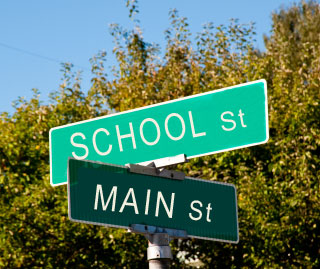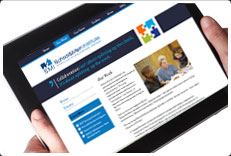Frequently Asked Questions
What kind of a name is School & Main Institute? Are you in Maine?

- School & Main streets: The cross streets of community life, where education, business, and community organizations intersect.
- Institute: A place for learning. There was no “partnership development/community collaboration college." We thought there should be.
What is School & Main Institute? Can you describe what you do in a sentence?
We are a not-for-profit organization that specializes in developing collaborative responses to issues in education, workforce, youth and community development.
Bottom line: We help organizations work together – across institutional lines or in “uncommon coalitions” – to improve their communities and the lives of young people living in them.
As former Surgeon General Jocelyn Elders put it years ago: Collaboration is "an unnatural act between non-consenting adults.” We’ve spent 27 years developing methods that help people get natural about collaboration. We do it because we firmly believe that the most deeply-rooted issues affecting youth and community life require us to work together across organizations.
How long has School & Main Institute been doing this work?
School & Main Institute started as an R&D group in Brandeis University’s Heller School for Social Policy and Management in 1985. We eventually left the nest in 1991 and have since developed into a nationally recognized, independent non-profit organization with a rich history of supporting national, state and local education, workforce, and youth development efforts around the country. Over the years, SMI has been recognized for the extraordinary effectiveness of our work by FORTUNE Magazine, the US Chamber of Commerce's Center for Workforce Preparation, the Council on Aid to Education, the American Youth Policy Forum, and others.
What does School & Main Institute do?
Our projects and services are tailored to each client and community. On any given day, you might find us:
- Leading a training or strategic planning session
- Facilitating a meeting of community leaders
- Organizing a peer exchange conference or training institute
- Helping staff in key positions navigate collaborative project management
- Conducting program evaluation activities
- Working with a client and partners to design a sustainable response to a youth-related issue like dropout prevention, youth transition, parent involvement, or wraparound support models
In our early days, we also developed national pilots and demonstration projects like Career Beginnings, Higher Ground and Futures 2000 – all referenced in the American Youth Policy Forum’s SOME Things DO Make a Difference for Youth compendium.
The common thread through our work is our belief in the power of collaboration and our experience actually doing it – leveraging the best out of the organizations, people, and partners in the wide variety of settings and projects we’ve been involved in over the years.
Where does School & Main Institute work?
School & Main Institute has worked in 35 states and in hundreds of communities across the country. We have supported local school systems and community organizations, state and federal agencies, and national organizations. We have also developed national demonstration programs and projects for funders like Carnegie, General Electric, Dewitt Wallace, Pew and Mott.
What makes SMI’s strategies so successful?
In a field that can often be complex, our methods get at core fundamentals that are often overlooked. Most of us are good at managing projects and programs. But managing changes to systems? Collaborative change? This can quickly turn into a lot of meetings that lead nowhere, where people say what they really think after the meeting, in the parking lot (the real meeting!). SMI’s methods and tools have been tested over many years and appeal to people because they are practical, rooted in their experience and create the “glue” people need to take collaborative action. And we are tenacious “roll up our sleeves” people. We are there, deep in the work, with you – a partner, guide, and guardian of vision.
What lessons has School & Main Institute learned from its work across the country?
Someday we’ll write the book! For now, here are few of the key observations and lessons – things we never forget as we work with clients.
- Collaboration takes skill...it truly does. Talk with any coordinator asked to assume responsibility for a collaborative venture that involves multiple organizations. The lines of authority and accountability, relationships, organizational cultures and calendars are all different. Not many people go to school to learn how to do this type of work. We try to make the skill set and competencies needed for this work explicit, especially for those “managing in the middle” of a collaborative effort.
- Most communities are “activities rich yet systems poor.” They have many good programs, organizations, even untapped resources, but the left hand doesn’t know what the right hand is doing. Things aren’t connected in ways that could maximize resources and results. And there’s no filter or coordinated methodology for deciding if you need to add anything else (or get rid of something). Many people see this situation clearly enough but don’t know what to do about it or don’t have the leverage they need to do anything about it.
- “One person deep” collaborations are just that: not deep. Communities are strewn with committees and partnership groups that take a “partnership by representatives” approach rather than creating the deep organizational commitments and top-to-bottom/side-to-side depth and breadth needed to sustain collaborative work.
- Turf, competition, and organizational interests are real. Organizations often have competing goals, hound after the same funders, and have different points of view. We help people understand how to identify mutual "self interest" and find ways to navigate (even maximize!) the differences between systems.
As an organization that has worked in many places, in what can be very challenging work (“if collaboration is such a good idea, why is it so hard?”), we take the long view. At the same time, we make sure to find short term wins that help people who need to work together do so and enjoy it.




 Login
Login